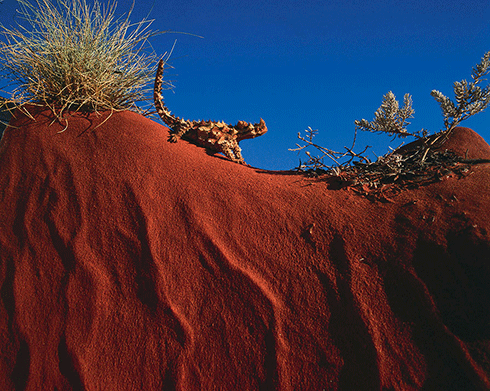
|
Published: 29 September 2014
Wild Australia: ecologists meet at our red heart
Australia’s leading ecologists are meeting in the red heart of the country today to present the latest research that will help solve the nation’s most pressing environmental problems.

|
|
A thorny devil, one of the diverse inhabitants of Australia’s red centre. Credit:
Tourism NT
|
More than 500 ecologists, policy makers and land managers will be in Alice Springs for the annual Ecological Society of Australia (ESA) conference.
The ESA is the peak group of ecologists in Australia, and promotes the application of ecological principles in the development, use and conservation of Australia's natural resources.
Conference chair, CSIRO’s Professor Alan Andersen, said the red centre is the ideal meeting place for researchers and stakeholders from across the country.
‘We will be embracing a diversity of world views and approaches at the ESA conference in Alice Springs, as this is likely to lead to the best new ideas in ecology and solutions for environmental management,’ he said.
The conference will feature symposia on regionally relevant issues such as arid ecology, the ecology of northern development and Indigenous ecological knowledge.
Researchers from CSIRO's Land and Water Flagship will be convening two key symposia: one on savanna burning, led by Dr Garry Cook, and another on Indigenous knowledge, led by Josie Douglas.
Ms Douglas will explore how young Aboriginal people adapt and shape ecological knowledge in modern everyday life amongst kin and in relation to their country.
An Indigenous Ecological Knowledge symposium will be convened on Arrernte country on Tuesday, as part of the conference. The event will bring together Aboriginal speakers and their colleagues from across Australia, from Bardi and Jawi country in the Kimberley to Gunditj Mirring country in Victoria.
Ms Douglas said the presenters will speak about their roles in cultural and natural resource management.
Ecologists at the ESA conference will also share their findings on native mammal decline and how northern Australian landscapes can be better managed to reverse this decline.
Australia’s tropical savannas are one of the most fire-prone environments in the world, due to the region’s long dry season. While these savannas make up around 20 per cent of the country’s landmass, they account for 75 per cent of the total area burnt each year.
Recent research has implicated predation by feral cats as a major driver of mammal decline, but cat predation may be influenced by other factors such as fire, which may also have direct impacts on mammal numbers.
Mammals can survive during and after some fires, but their ability to find cover and food, and to reproduce or retain their numbers can be drastically reduced.
Dr Graeme Gillespie, whose research comes under the National Environmental Research Program (NERP) is chairing a special session on mammal decline.
‘Many people start fires without it being part of an overall plan to manage the landscape,’ he said. ‘We could increase the survival chances of native mammals by managing fire to reduce its frequency, extent and intensity.’
NERP partner, the Australian Wildlife Conservancy (AWC), has been a leader in implementing improved fire research and management through its EcoFire project n the Kimberley. Research undertaken at AWC’s Mornington Wildlife Sanctuary has shown that fire allows other threats, such as predation by feral cats, to have a much bigger impact on native mammal populations.
‘Mammal mortality is likely to be higher after more intense fires because after an intense fire, extensive burnt ground offers few refuges and they are easily picked off by cats,’ said the AWC’s Dr Sarah Legge.
‘Fire management protocols need to be evidence-based. They should also include targets that leave large areas unburnt for between three and ten years, and ongoing monitoring.’
Source: ESA



